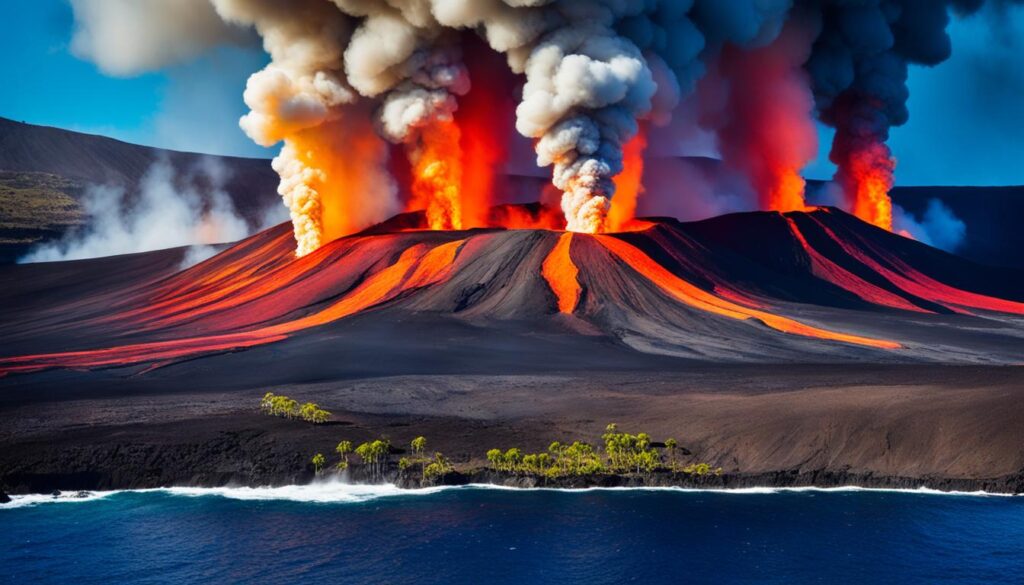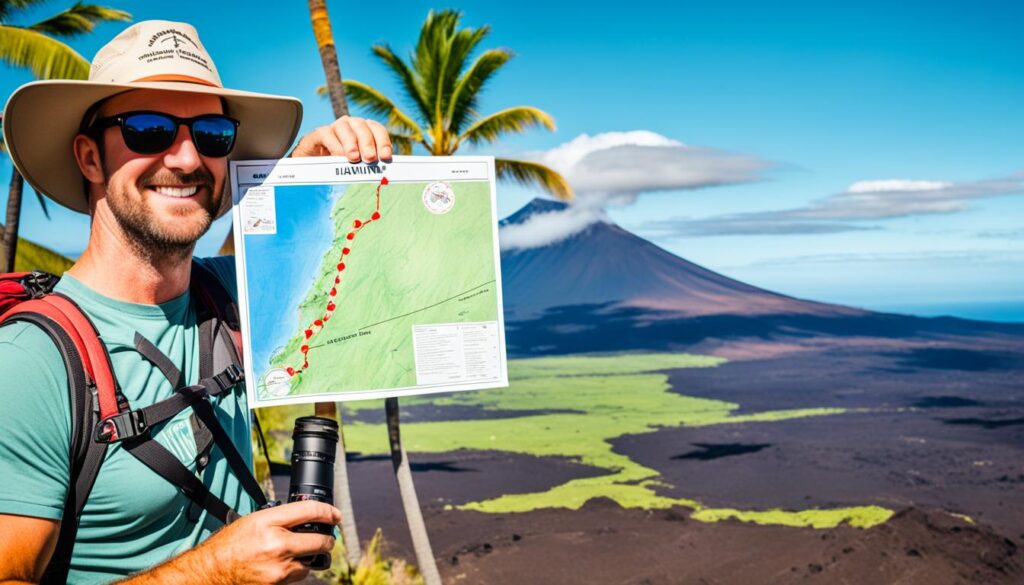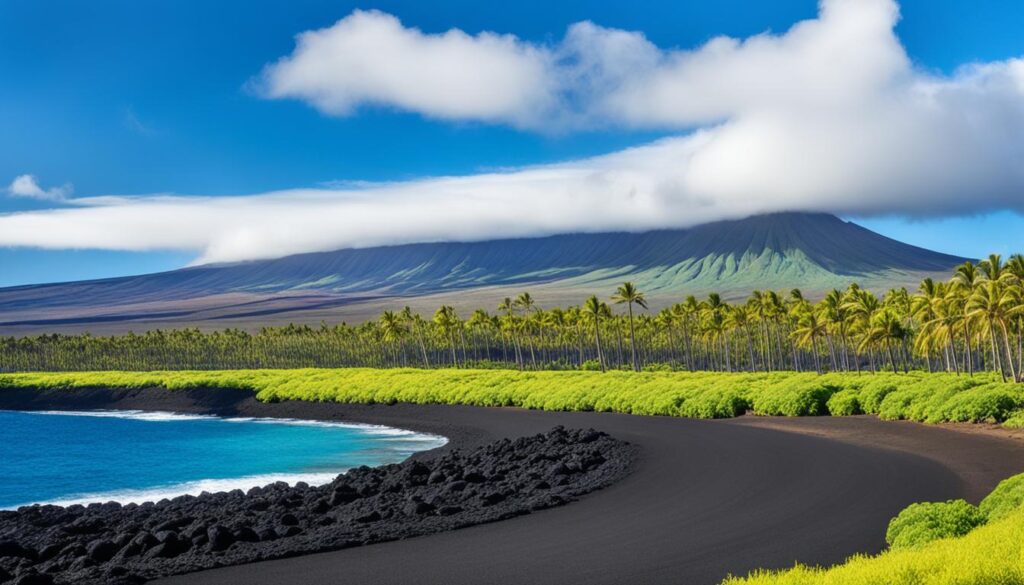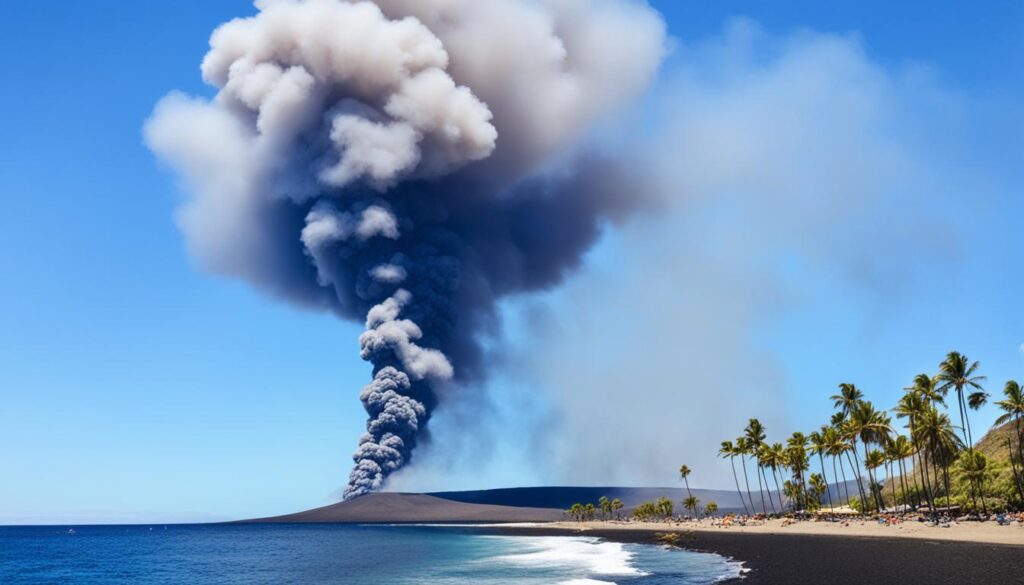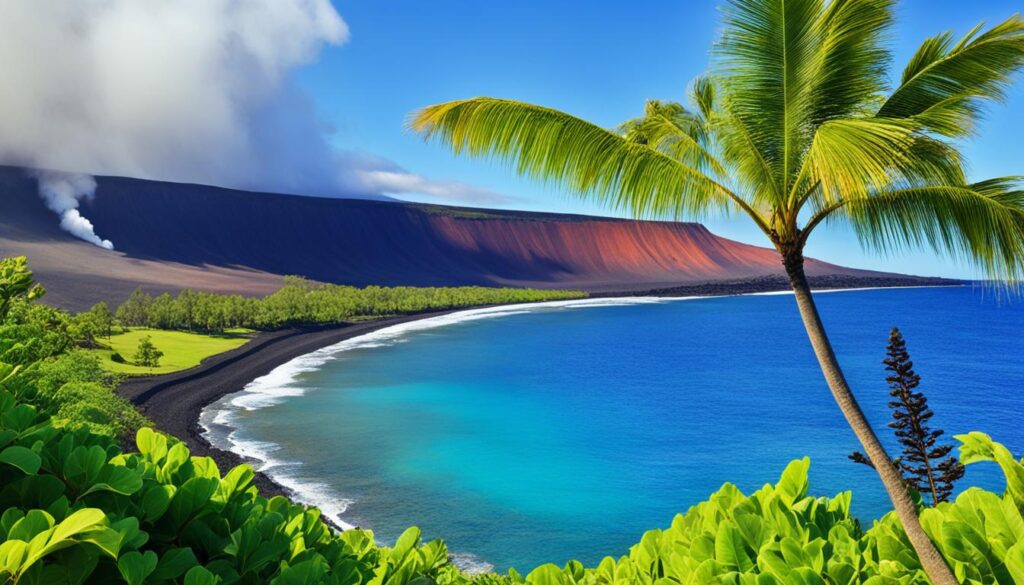Is it safe to visit Hawaii Island amidst the eruption of Mauna Loa? As tourists flock to this tropical paradise, the impact of the volcanic activity raises concerns about safety. How does the ongoing eruption affect your travel plans? Are there any travel advisories in place? Let’s explore the safety considerations and find out how you can navigate the island while ensuring a secure and unforgettable experience.
Understanding the Mauna Loa Eruption
As visitors plan their trip to Hawaii Island, it’s important to have a clear understanding of the Mauna Loa eruption and its impact on the volcanic activity. By familiarizing yourself with the current situation, you can make informed decisions about your travel plans and ensure your safety throughout your visit.
The Mauna Loa eruption is an ongoing volcanic event that has the potential to affect various aspects of travel on Hawaii Island. As one of the world’s largest active volcanoes, Mauna Loa poses certain risks that visitors should be aware of.
The eruption has led to increased volcanic activity, including lava flows and gas emissions. These factors can impact air quality and create hazardous conditions, especially in areas close to the volcano. It is essential to stay informed about the latest updates and advisories from local authorities to ensure your safety.
“The ongoing Mauna Loa eruption has created an environment where visitors need to exercise caution and adhere to safety guidelines to protect themselves,” says Dr. Emma Wilson, a geologist specializing in volcanic activity.
While the eruption may disrupt some tourist activities and attractions, the unique opportunity to witness the power of nature up close can also be an awe-inspiring experience. However, it is crucial to prioritize your safety and follow any instructions or warnings issued by local authorities.
Understanding the Risks
Proximity to the eruption site is an important factor to consider when assessing the risks associated with the Mauna Loa eruption. Areas closer to the volcano are likely to experience more significant impacts, such as ashfall and potential evacuation orders. It is advisable to avoid venturing into restricted areas and respect any closures or warnings.
Additionally, the volcanic gas emissions can affect air quality, especially in downwind areas. It is essential to monitor air quality reports and take necessary precautions, such as wearing protective masks if advised.
The role of local authorities and experts
Local authorities, including the Hawaiian Volcano Observatory and the Civil Defense Agency, play a vital role in monitoring the eruption and providing timely updates and guidance to the public. It is crucial to stay informed through official channels and follow their recommendations to ensure your safety during your visit.
Table: Impact of Mauna Loa Eruption on Travel
| Travel Aspect | Potential Impact |
|---|---|
| Tourist attractions | Some attractions may be closed or have restricted access due to safety concerns. |
| Outdoor activities | Certain activities, such as hiking or camping in affected areas, may be prohibited or restricted. |
| Transportation | There may be road closures or detours in place to ensure safe passage through affected areas. |
| Accommodation | Hotels in close proximity to the eruption site may have adjusted operations or limited availability. |
Understanding the potential impacts of the Mauna Loa eruption will help you make informed decisions about your travel plans and ensure a safe and enjoyable experience on Hawaii Island. By staying informed, following safety guidelines, and seeking advice from local authorities, you can navigate the volcanic activity with confidence.
Current Travel Updates
Stay up to date with the latest travel updates regarding Hawaii Island and the ongoing Mauna Loa eruption. We understand the importance of staying informed during your visit, so we’ve compiled the most relevant information on closures, restrictions, and safety guidelines.
Travel Closures and Restrictions
As the situation evolves, it’s essential to be aware of any closures or restrictions that may impact your travel plans. Here are the key updates:
| Attractions | Status |
|---|---|
| Hawaii Volcanoes National Park | Partially closed. Check the park website for the latest information on open areas and available activities. |
| Mauna Loa Observatory | Closed to visitors until further notice. |
| Puna Geothermal Venture | Closed. No tours or visits allowed at this time. |
Please note that these closures are subject to change depending on the volcanic activity and recommendations from local authorities. Stay informed through official channels and plan your itinerary accordingly.
Staying Informed
To ensure you have the most accurate and up-to-date information during your visit to Hawaii Island, here are some recommended sources:
- Local Authorities: Keep an eye on updates from the Hawaii County Civil Defense Agency and the Hawaii Tourism Authority.
- Official Websites: Visit the websites of attractions, national parks, and other tourist spots for specific information on closures and guidelines.
- News Outlets: Stay tuned to local news outlets for any breaking updates and travel advisories.
- Social Media: Follow official social media accounts of relevant organizations for immediate announcements and news.
By relying on these sources, you can stay informed about the latest developments and adjust your travel plans accordingly.
“Being aware of travel closures and staying informed are crucial steps in ensuring a safe and enjoyable visit to Hawaii Island during the Mauna Loa eruption.”
While the eruption of Mauna Loa may require some adjustments to your itinerary, with the right information, you can still experience the beauty and wonder of Hawaii Island. Plan ahead, stay informed, and make the most of your visit while prioritizing your safety and well-being.
Safety Precautions for Visitors
When visiting Hawaii Island during the ongoing eruption of Mauna Loa, it is crucial to prioritize your safety and take necessary precautions. By following these guidelines, you can ensure a secure and enjoyable experience on the island:
- Stay informed: Keep yourself updated with the latest information regarding the Mauna Loa eruption. Monitor local news, official government websites, and reliable sources for any travel advisories, evacuation notices, or changes in volcanic activity.
- Follow local guidelines: Observe and adhere to any safety instructions provided by local authorities. Respect any closures or restricted areas for your own safety and to prevent unnecessary risks.
- Be prepared: Carry essential emergency supplies, including a first aid kit, sufficient water, sunscreen, and comfortable walking shoes. Familiarize yourself with emergency evacuation routes and have a plan in place in case of unforeseen circumstances.
- Stay updated on air quality: Volcanic eruptions can lead to changes in air quality. Keep track of air quality indexes and limit outdoor activities if air quality is compromised. Consider wearing protective masks if necessary.
- Respect natural hazards: Hawaii Island is known for its unique volcanic landscape. Be mindful of potential hazards such as lava flows, rockfalls, and unstable ground. Stay on marked paths and trails to avoid accidents or injuries.
- Seek local advice: Consult with locals, park rangers, or tour guides who are experienced and knowledgeable about the island’s conditions. They can provide valuable insights on safe areas to explore and activities to enjoy.
By taking these safety precautions, you can make the most of your visit to Hawaii Island while minimizing any risks associated with the Mauna Loa eruption.
| Precaution | Description |
|---|---|
| Stay informed | Keep up-to-date with the latest information about the Mauna Loa eruption from reliable sources. |
| Follow local guidelines | Observe and comply with safety instructions and restrictions implemented by local authorities. |
| Be prepared | Carry emergency supplies and have an evacuation plan in case of emergencies. |
| Stay updated on air quality | Monitor air quality indexes and take necessary precautions if air quality is compromised. |
| Respect natural hazards | Exercise caution and stay on designated paths to avoid potential dangers. |
| Seek local advice | Consult with experienced locals or professionals for guidance on safe areas and activities. |
Remember, your safety is of utmost importance, and by following these precautions, you can enjoy your time on Hawaii Island while ensuring a memorable and secure trip.
Assessing Risk and Personal Safety
When visiting Hawaii Island during the ongoing Mauna Loa eruption, it is crucial to assess the risks involved and prioritize your personal safety. By considering factors such as proximity to the eruption, air quality, and potential evacuation procedures, you can make informed decisions to ensure a safe and enjoyable experience.
Evaluating Proximity to the Eruption
To determine the level of risk associated with the Mauna Loa eruption, consider your proximity to the volcanic activity. Stay updated with the latest information from local authorities, such as the Hawaii Volcanoes National Park or the U.S. Geological Survey. These organizations provide valuable insights into the areas affected by the eruption and any associated hazards.
In addition, be mindful of any travel advisories in place that may restrict access to certain locations near the eruption site. Prioritize safety by adhering to these advisories and avoiding restricted areas.
Monitoring Air Quality
Volcanic eruptions can release hazardous gases and pollutants into the air, which may affect air quality on Hawaii Island. It is essential to stay informed about the air quality conditions during your visit.
Monitor the Air Quality Index (AQI) provided by the Environmental Protection Agency (EPA) or other trusted sources. If the AQI indicates unhealthy conditions, consider limiting your outdoor activities or wearing appropriate respiratory protection, such as face masks, especially if you have any respiratory or health concerns.
Understanding Evacuation Procedures
While rare, the possibility of an evacuation due to volcanic activity should be considered. Familiarize yourself with the evacuation procedures provided by local authorities and accommodations. Be aware of the designated evacuation routes, shelters, and emergency contact information.
Stay alert for any emergency notifications or alerts from local authorities, as these will provide critical information and guidance during a potential evacuation. Being prepared and aware of evacuation procedures can help ensure your safety during your time on Hawaii Island.
| Risk Factors | Safety Measures |
|---|---|
| Proximity to the eruption | Stay updated with local authorities and adhere to any travel advisories or restrictions. |
| Air quality | Monitor the Air Quality Index (AQI) and take necessary precautions if conditions are unhealthy. |
| Potential evacuation | Familiarize yourself with evacuation procedures, designated routes, and emergency contact information. |
Tourist Attractions and Activities
Exploring the captivating beauty of Hawaii Island is a must-do for any visitor, but it’s essential to be aware of the impact of the ongoing Mauna Loa eruption on popular tourist attractions and activities. While some sites may be closed or inaccessible due to safety concerns, there are still plenty of incredible experiences to discover during your stay.
“Despite the challenges posed by the Mauna Loa eruption, Hawaii Island continues to offer a wealth of unique and awe-inspiring attractions,” says travel expert Jane Smith. “Visitors can immerse themselves in the island’s natural wonders and cultural heritage while prioritizing safety.”
The Volcanoes National Park Experience
A visit to Hawaii Island is incomplete without exploring the renowned Volcanoes National Park. While certain areas of the park may be temporarily closed for visitor safety, there are still opportunities to witness the astonishing power of nature. The iconic Kilauea volcano, although not directly impacted by the Mauna Loa eruption, offers mesmerizing views and the chance to learn about the island’s volcanic history.
Immerse Yourself in Natural Wonders
Indulge in the island’s breathtaking natural beauty by visiting the lush rainforests, cascading waterfalls, and pristine beaches that dot Hawaii Island. Explore the stunning Akaka Falls State Park, hike along the captivating Hamakua Coast, or marvel at the vibrant marine life while snorkeling or diving in the crystal-clear waters.
Discover Cultural Treasures
Despite any disruptions caused by the eruption, Hawaii Island remains a treasure trove of culture and heritage. Delve into the island’s rich history by visiting sacred sites such as Pu’uhonua O Honaunau National Historical Park or taking part in a traditional Hawaiian luau. Engage with local communities and learn about their customs, music, and dance to gain a deeper appreciation for the island’s vibrant culture.
Alternative Outdoor Activities
If some of the popular attractions are temporarily unavailable, don’t fret. Hawaii Island offers a myriad of outdoor activities that allow visitors to savor the island’s natural wonders. From hiking and biking trails to kayaking and whale watching tours, there are endless opportunities to create unforgettable memories amid the island’s picturesque landscapes.
“While the Mauna Loa eruption may have impacted certain tourist attractions and activities, it is important to adapt and embrace the alternative experiences available,” advises local guide David Johnson. “Visitors can still enjoy the beauty of Hawaii Island while ensuring their safety and wellbeing.”
Continue to Section 7 to learn more about the local support and emergency services available during the Mauna Loa eruption to ensure a secure and memorable visit to Hawaii Island.
Local Support and Emergency Services
During your visit to Hawaii Island amidst the Mauna Loa eruption, it’s essential to familiarize yourself with the local support and emergency services available. Knowing who to contact and where to go in case of any unforeseen circumstances can provide peace of mind and ensure your safety.
Emergency Contact Numbers
In the event of an emergency, it’s crucial to have the appropriate contact numbers readily available. Here are some important numbers you should save in your phone:
- Emergency Services: Dial 911 for immediate assistance from the police, fire department, or ambulance.
- Hawaii Island Civil Defense: Contact the Hawaii Island Civil Defense Agency at (808) 935-0031 for updates on emergency situations and official advisories.
Make sure to have your location information readily available when contacting emergency services to expedite the response time.
Medical Facilities
In the event of a medical emergency or if you require medical assistance during your time on Hawaii Island, here are some medical facilities you can turn to:
| Medical Facility | Contact Number | Location |
|---|---|---|
| Hilo Medical Center | (808) 932-3000 | Hilo |
| Kona Community Hospital | (808) 322-9311 | Kailua-Kona |
| North Hawaii Community Hospital | (808) 885-4444 | Kamuela |
| Queen’s North Hawaii Community Hospital | (808) 885-4444 | Kamuela |
These medical facilities are equipped to handle a range of medical needs and emergencies and have experienced professionals ready to assist you.
Other Resources
In addition to emergency services and medical facilities, it’s helpful to be aware of other resources available to visitors on Hawaii Island. Here are a few resources you might find useful:
“Knowing the local support and emergency services available during your visit to Hawaii Island can provide peace of mind and ensure your safety.”
- Tourist Information Centers: Visit local tourist information centers, such as the Hawaii Visitors and Conventions Bureau, for up-to-date information on attractions, closures, and any travel advisories.
- Transportation Services: Familiarize yourself with transportation options on the island, including taxi services, car rental companies, and public transportation, to have reliable means of travel.
- Consular Services: If you are a foreign visitor, contact your country’s embassy or consulate for assistance in case of emergencies or any consular services you may require.
By being prepared and having access to the necessary resources, you can confidently explore Hawaii Island while keeping your safety a priority.
Recommended Travel Itinerary
Planning a trip to Hawaii Island amidst the Mauna Loa eruption? Don’t worry, we’ve got you covered! Our recommended travel itinerary takes into account the safety considerations surrounding the eruption while ensuring you have a memorable and secure experience. Explore the island’s breathtaking attractions and engage in exciting activities that are not affected by the volcanic activity.
Day 1: Discovering Natural Wonders
Start your adventure with a visit to Akaka Falls State Park. Immerse yourself in the lush greenery and witness the stunning 422-foot waterfall, surrounded by native Hawaiian flora. Continue your journey to Hawaii Volcanoes National Park, where you can marvel at the power of nature as you explore volcanic craters, walk through lava tubes, and witness the mesmerizing glow of active lava (safely from designated viewpoints).
Day 2: Coastal Exploration
Embark on a scenic drive along the legendary Chain of Craters Road. Take in the breathtaking coastal views and stop at various lookout points to witness the geological wonders created by the island’s volcanic activity. Don’t miss a visit to Punalu’u Black Sand Beach, where you can spot Hawaiian green sea turtles basking in the sun.
Day 3: Cultural Immersion
Immerse yourself in the rich cultural heritage of Hawaii Island by visiting the Pu’uhonua o Honaunau National Historical Park. Learn about ancient Hawaiian customs, explore sacred grounds, and witness traditional hula performances. Continue your cultural journey with a visit to the vibrant farmer’s markets in Hilo, where you can taste local delicacies and shop for unique souvenirs.
Day 4: Adventure in the Mountains
Head to the stunning Waipio Valley and experience its breathtaking beauty. Take a guided hike or horseback ride along the valley floor, surrounded by cascading waterfalls, lush forests, and taro fields. For an adrenaline rush, embark on a ziplining adventure through the scenic landscapes of North Kohala.
Day 5: Relaxation and Wellness
Indulge in a day of relaxation and rejuvenation at one of Hawaii Island’s renowned spas and wellness retreats. Enjoy traditional Hawaiian healing treatments and immerse yourself in the tranquility of the island’s natural surroundings. Unwind with a leisurely beach day at one of the pristine white sand beaches along the Kona coast.
| Attraction/Activity | Operating Status |
|---|---|
| Akaka Falls State Park | Open |
| Hawaii Volcanoes National Park | Open with limited access to the eruption area |
| Punalu’u Black Sand Beach | Open |
| Pu’uhonua o Honaunau National Historical Park | Open with modified visitor experiences |
| Waipio Valley | Open |
Remember to stay informed about any travel advisories or site closures due to the Mauna Loa eruption. Check official sources, such as the Hawaii County Civil Defense, for the latest updates. Enjoy your trip to Hawaii Island, and embrace the wonders of the island while prioritizing your safety and well-being.
Cultural and Environmental Impacts
The eruption of Mauna Loa has not only posed safety concerns but also had significant cultural and environmental impacts on Hawaii Island. The local community and the island’s natural beauty and rich heritage have been greatly affected by this natural phenomenon.
The eruption has disrupted the daily lives of the residents, who have had to adapt to the changing conditions. Local businesses relying on tourism have seen a decline in visitors due to safety concerns, impacting the economy of the island. The eruption has also disrupted traditional cultural activities and events, which play a crucial role in preserving and celebrating the unique Hawaiian culture.
“The eruption may have fundamentally changed the landscape, but it has also brought our community together in new ways. We are resilient and determined to protect our island’s cultural heritage,” said Kamehameha Schools educator, Keola Nakanishi.
Efforts are underway to mitigate the environmental impacts of the eruption and preserve the island’s natural resources. Organizations and volunteers are actively involved in clean-up initiatives to restore affected areas. Additionally, steps are being taken to ensure the long-term protection and conservation of the island’s sensitive ecosystems.
Preserving Cultural Heritage
Despite the challenges posed by the eruption, the local community is committed to preserving its cultural heritage. Various cultural centers and museums have implemented measures to safeguard their collections and artifacts. They continue to educate visitors about the rich history and traditions of Hawaii Island, providing insights into the island’s past.
Environment Conservation Initiatives
Environmental organizations and government agencies are working together to mitigate the impacts on the island’s ecosystems. Efforts are being made to restore affected areas and protect endangered species. In collaboration with local communities, these initiatives aim to ensure the long-term sustainability of Hawaii Island’s natural environment.
While the Mauna Loa eruption has left a lasting impact on the cultural and environmental landscape of Hawaii Island, the resilience and dedication of the local community provide hope for a vibrant future. Visitors are encouraged to support these conservation efforts and experience the unique cultural heritage that defines this remarkable island.
Conclusion
In conclusion, the safety considerations for visiting Hawaii Island during the Mauna Loa eruption are important to keep in mind. While there may be some precautions to take and potential disruptions to tourist activities, it is still possible to have a safe and enjoyable visit to this beautiful island. By staying informed about the latest updates and following local guidelines, you can make the most of your time in Hawaii.
The eruption of Mauna Loa should not deter you from experiencing the unique attractions and activities that Hawaii Island has to offer. Many of the island’s popular tourist sites remain unaffected, allowing you to explore its stunning landscapes, indulge in water sports, and immerse yourself in the local culture.
Remember to prioritize your personal safety by assessing the risks associated with the eruption, such as the proximity to the eruption site and the air quality. Be prepared for any potential hazards and familiarize yourself with evacuation procedures. Additionally, make use of the local support and emergency services available on the island should you require assistance.






























